Geographical Origin Discrimination of White Rice Based on Image Pixel Size Using Hyperspectral Fluorescence Imaging Analysis
Abstract
1. Introduction
2. Materials and Methods
2.1. Materials
2.2. Hyperspectral Imaging System
2.3. Multivariate Data Analysis
2.3.1. Image Post-Processing
2.3.2. Spectrum Pre-Treatment
2.3.3. Model Validation
2.4. PLS Image Analysis
3. Results and Discussion
3.1. Spectral Characteristics of South Korean and Chinese Rice
3.2. Performances of the Geographical Origin Discrimination Models for South Korean and Chinese Rice by Pixel Dimensions
3.3. Discrimination Models for South Korean and Chinese Rice Using Pre-Treatments
3.4. Results of PLS Image Discrimination of South Korean and Chinese Rice
4. Conclusions
Author Contributions
Funding
Acknowledgments
Conflicts of Interest
References
- Mo, C.; Lim, J.; Kwon, S.W.; Lim, D.K.; Kim, M.S.; Kim, G.; Kang, J.; Kwon, K.D.; Cho, B.K. Hyperspectral imaging and partial least square discriminant analysis for geographical origin discrimination of white rice. J. Biosyst. Eng. 2017, 42, 293–300. [Google Scholar]
- Suzuki, Y.; Chikaraishi, Y.; Ogawa, N.O.; Ohkouchi, N.; Korenaga, T. Geographical origin of polished rice based on multiple element and stable isotope analyses. Food Chem. 2008, 109, 470–475. [Google Scholar] [CrossRef] [PubMed]
- Lim, D.K.; Mo, C.; Lee, D.K.; Long, N.P.; Lim, J.; Kwon, S.W. Non-destructive profiling of volatile organic compounds using HS-SPME/GC–MS and its application for the geographical discrimination of white rice. J. Food Drug Anal. 2018, 26, 260–267. [Google Scholar] [CrossRef] [PubMed]
- Wang, J.; Chen, T.; Zhang, W.; Zhao, Y.; Yang, S.; Chen, A. Tracing the geographical origin of rice by stable isotopic analyses combined with chemometrics. Food Chem. 2020, 313, 126093. [Google Scholar] [CrossRef]
- Cheajesadagul, P.; Arnaudguilhem, C.; Shiowatana, J.; Siripinyanond, A.; Szpunar, J. Discrimination of geographical origin of rice based on multi-element fingerprinting by high resolution inductively coupled plasma mass spectrometry. Food Chem. 2013, 141, 3504–3509. [Google Scholar] [CrossRef]
- Sabir, A.; Rafi, M.; Darusman, L.K. Discrimination of red and white rice bran from Indonesia using HPLC fingerprint analysis combined with chemometrics. Food Chem. 2017, 221, 1717–1722. [Google Scholar] [CrossRef]
- Ahn, H.G.; Kim, Y.H. Discrimination of korean domestic and foreign soybeans using near infrared reflectance spectroscopy. Korean J. Crop. Sci. 2012, 57, 296–300. [Google Scholar] [CrossRef]
- Huo, Y.; Kamal, G.M.; Wang, J.; Liu, H.; Zhang, G.; Hu, Z.; Anwar, F.; Du, H. 1H NMR-based metabolomics for discrimination of rice from different geographical origins of China. J. Cereal Sci. 2017, 76, 243–252. [Google Scholar] [CrossRef]
- Nogales-Bueno, J.; Feliz, L.; Baca-Bocanegra, B.; Hernández-Hierro, J.M.; Heredia, F.J.; Barroso, J.M.; Rato, A.E. Comparative study on the use of three different near infrared spectroscopy recording methodologies for varietal discrimination of walnuts. Talanta 2020, 206, 120189. [Google Scholar] [CrossRef]
- Emwas, A.H.M. The strengths and weaknesses of NMR spectroscopy and mass spectrometry with particular focus on metabolomics research. In Metabonomics: Methods and Protocols; Bjerrum, J.T., Ed.; Springer: New York, NY, USA, 2015; pp. 161–193. ISBN 978-1-4939-2377-9. [Google Scholar]
- Kim, W.K.; Hong, S.J.; Cui, J.; Kim, H.J.; Park, J.; Yang, S.H.; Kim, G. Application of NIR spectroscopy and artificial neural network techniques for real-time discrimination of soil categories. J. Korean Soc. Nondestruct. Test. 2017, 37, 148–157. [Google Scholar] [CrossRef]
- Mo, C.; Kim, M.S.; Lim, J.; Lee, K.; Kim, G.; Cho, B.K. Multispectral Fluorescence Imaging Technique for for discrimination of cucumber seed viability. Trans. ASABE 2015, 58, 959–968. [Google Scholar]
- Mo, C.; Kim, M.S.; Kim, G.; Cheong, E.J.; Yang, J.; Lim, J. Detecting drought stress in soybean plants using hyperspectral fluorescence imaging. J. Biosyst. Eng. 2015, 40, 335–344. [Google Scholar] [CrossRef]
- Mo, C.; Kim, G.; Kim, M.S.; Lim, J.; Cho, H.; Barnaby, J.Y.; Cho, B.K. Fluorescence hyperspectral imaging technique for foreign substance detection on fresh-cut lettuce. J. Sci. Food Agric. 2017, 97, 3985–3993. [Google Scholar] [CrossRef] [PubMed]
- Mo, C.; Hasegawa, M.; Lee, K.; Lim, J.G.; Kim, M.S.; Kang, S.; Lee, H.D.; Bae, H.; Kim, D.Y.; Cho, B.K. Development of a non-destructive on-line pungency measurement system for red-pepper powder. J. Fac. Agric. Kyushu Univ. 2013, 58, 137–144. [Google Scholar]
- Hong, S.J.; Lee, A.Y.; Han, Y.; Park, J.; So, J.D.; Kim, G. Rancidity prediction of soybean oil by using near-infrared spectroscopy techniques. J. Biosyst. Eng. 2018, 43, 219–228. [Google Scholar]
- Karoui, R.; Dufour, É.; Pillonel, L.; Picque, D.; Cattenoz, T. Determining the geographic origin of Emmental cheeses produced during winter and summer using a technique based on the concatenation of MIR and fluorescence spectroscopic data. Eur. Food Res. Technol. 2004, 219, 184–189. [Google Scholar] [CrossRef]
- Botelho, B.G.; Oliveira, L.S.; Franca, A.S. Fluorescence spectroscopy as tool for the geographical discrimination of coffees produced in different regions of Minas Gerais State in Brazil. Food Control 2017, 77, 25–31. [Google Scholar] [CrossRef]
- Yoon, S.C.; Shin, T.S.; Heitschmidt, G.W.; Lawrence, K.C.; Park, B.; Gamble, G. hyperspectral image recovery using a color camera for detecting colonies of foodborne pathogens on agar plate. J. Biosyst. Eng. 2019, 44, 169–185. [Google Scholar] [CrossRef]
- Ning, X.F.; Gong, Y.J.; Chen, Y.L.; Li, H. Construction of a ginsenoside content-predicting model based on hyperspectral imaging. J. Biosyst. Eng. 2018, 43, 369–378. [Google Scholar]
- Noh, H.K.; Lu, R. Hyperspectral laser-induced fluorescence imaging for assessing apple fruit quality. Postharvest Biol. Technol. 2007, 43, 193–201. [Google Scholar] [CrossRef]
- Tahir, H.E.; Arslan, M.; Mahunu, G.K.; Mariod, A.A.; Wen, Z.; Xiaobo, Z.; Xiaowei, H.; Jiyong, S.; El-Seedi, H. Authentication of the geographical origin of Roselle (Hibiscus sabdariffa L) using various spectroscopies: NIR, low-field NMR and fluorescence. Food Control. 2020, 114, 107231. [Google Scholar] [CrossRef]
- Hwang, J.; Kang, S.; Lee, K.; Chung, H. Enhanced Raman spectroscopic discrimination of the geographical origins of rice samples via transmission spectral collection through packed grains. Talanta 2012, 101, 488–494. [Google Scholar] [CrossRef] [PubMed]
- Chan, H.P.; Vyborny, C.J.; MacMahon, H.; Metz, C.E.; Doi, K.; Sickles, E.A. Digital mammography. ROC studies of the effects of pixel size and unsharp-mask filtering on the detection of subtle microcalcifications. Investig. Radiol. 1987, 22, 581–589. [Google Scholar] [CrossRef]
- Boellaard, R.; Krak, N.C.; Hoekstra, O.S.; Lammertsma, A.A. Effects of noise, image resolution, and ROI definition on the accuracy of standard uptake values: A simulation study. J. Nucl. Med. 2004, 45, 1519–1527. [Google Scholar] [PubMed]
- Chan, L.H.; Law, N.F.; Siu, W.C. A confidence map and pixel-based weighted correlation for PRNU-based camera identification. Digit. Investig. 2013, 10, 215–225. [Google Scholar] [CrossRef]
- Roger, J.M.; Chauchard, F.; Bellon-Maurel, V. EPO-PLS external parameter orthogonalisation of PLS application to temperature-independent measurement of sugar content of intact fruits. Chemom. Intell. Lab. Syst. 2003, 66, 191–204. [Google Scholar] [CrossRef]
- Cheetham, N.W.; Tao, L. Variation in crystalline type with amylose content in maize starch granules: An X-ray powder diffraction study. Carbohydr. Polym. 1998, 36, 277–284. [Google Scholar] [CrossRef]
- Cano, A.; Jiménez, A.; Cháfer, M.; Gónzalez, C.; Chiralt, A. Effect of amylose:amylopectin ratio and rice bran addition on starch films properties. Carbohydr. Polym. 2014, 111, 543–555. [Google Scholar] [CrossRef]
- Li, D.; Wang, X.; Han, C. Study on the fluorescence spectra characteristics of vinegar-water solutions. J. Spectrosc. 2016, 2016. [Google Scholar] [CrossRef]
- Moon, Y.H.; Kwon, Y.R.; Ahn, B.K.; Lee, J.H.; Choi, D.C. Determination of nitrogen fertilizer recommendation rates estimated by soil-testing for different types of paddy soils. Korean J. Environ. Agric. 2010, 29, 33–38. [Google Scholar] [CrossRef][Green Version]
- Sinha, R.P.; Sinha, J.P.; Gröniger, A.; Häder, D.P. Polychromatic action spectrum for the induction of a mycosporine-like amino acid in a rice-field cyanobacterium, Anabaena sp. J. Photochem. Photobiol. B Biol. 2002, 66, 47–53. [Google Scholar] [CrossRef]
- Singh, S.P.; Sinha, R.P.; Klisch, M.; Häder, D.P. Mycosporine-like amino acids (MAAs) profile of a rice-field cyanobacterium Anabaena doliolum as influenced by PAR and UVR. Planta 2008, 229, 225–233. [Google Scholar] [CrossRef]
- Wang, Z.H.; Wang, Y.; Cui, H.R.; Xia, Y.W.; Altosaar, I.; Shu, Q.Y. Factor analysis of physicochemical properties of 63 rice varieties. J. Sci. Food Agric. 2002, 82, 745–752. [Google Scholar]
- Song, J.; Kim, J.; Kim, D.; Lee, C.; Youn, J.; Kim, S.; Suh, S. Physicochemical properties of starches in japonica rices of differenct amylose content. Korean J. Crop. Sci. 2008, 53, 285–291. [Google Scholar]
- Özyigit, Y.; Bilgen, M. Use of spectral reflectance values for determining nitrogen, phosphorus, and potassium contents of rangeland plants. J. Agric. Sci. Technol. 2013, 15, 1537–1545. [Google Scholar]
- Du, M.; Fang, Y.; Shen, F.; Mao, B.; Zou, Y.; Li, P.; Pei, F.; Hu, Q. Multiangle discrimination of geographical origin of rice based on analysis of mineral elements and characteristic volatile components. Int. J. Food Sci. Technol. 2018, 53, 2088–2096. [Google Scholar] [CrossRef]
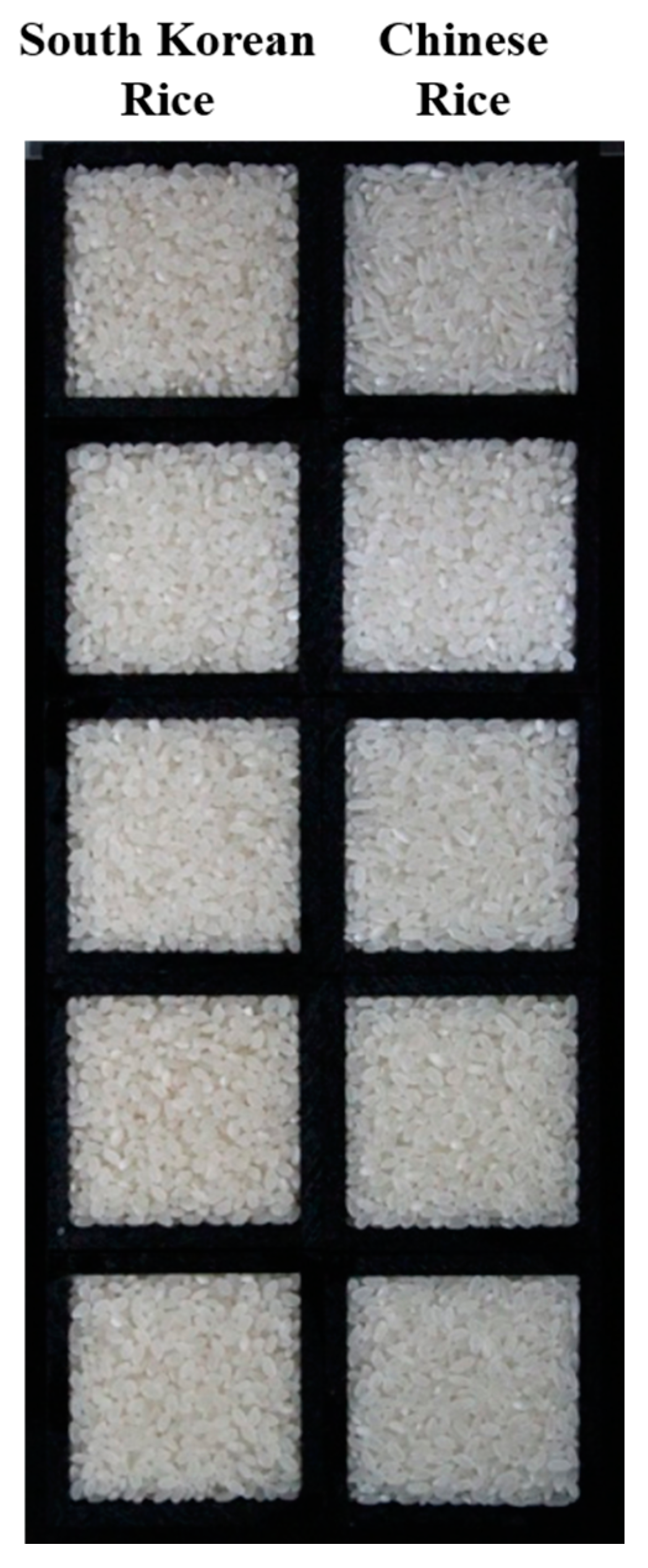

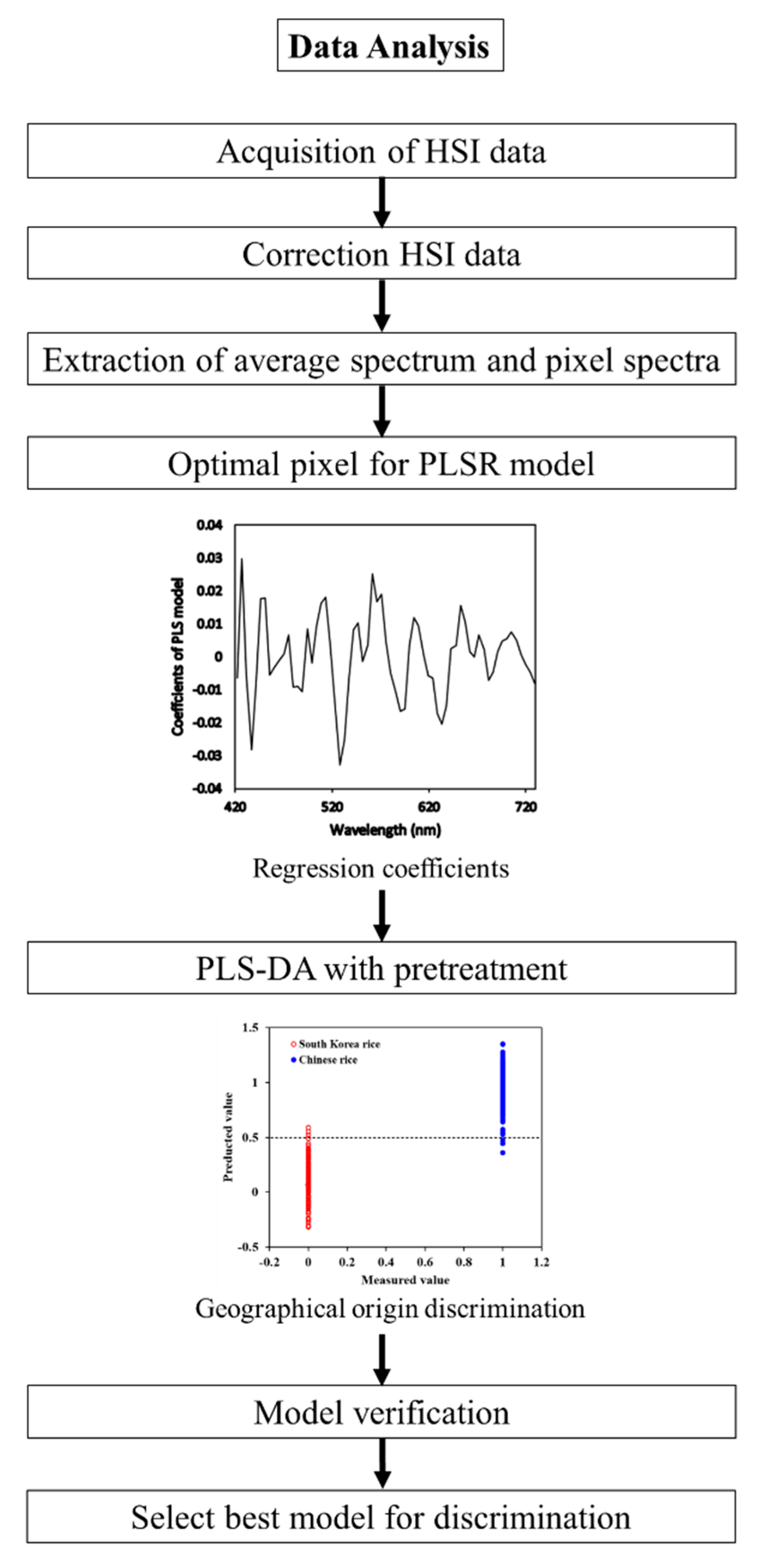
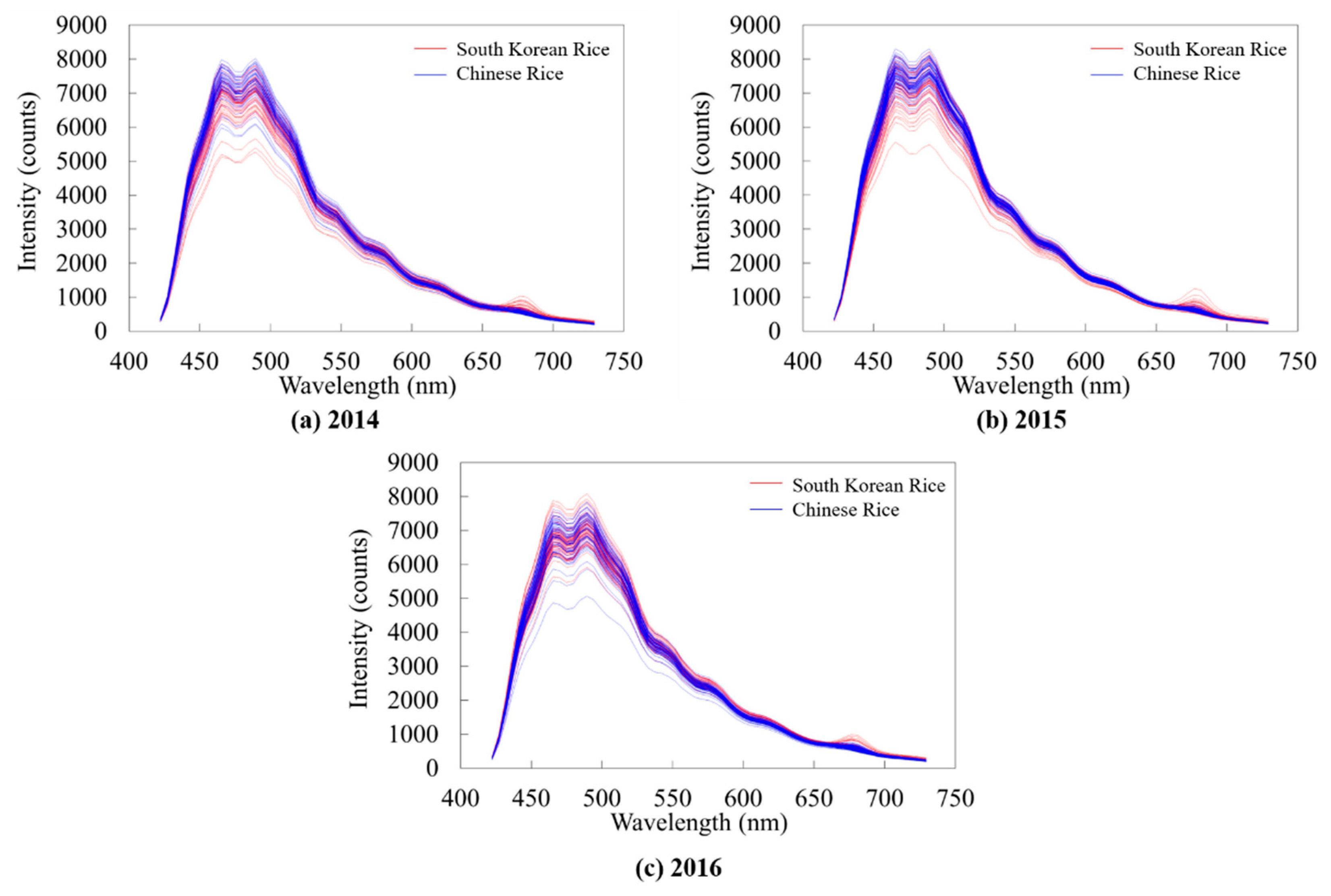
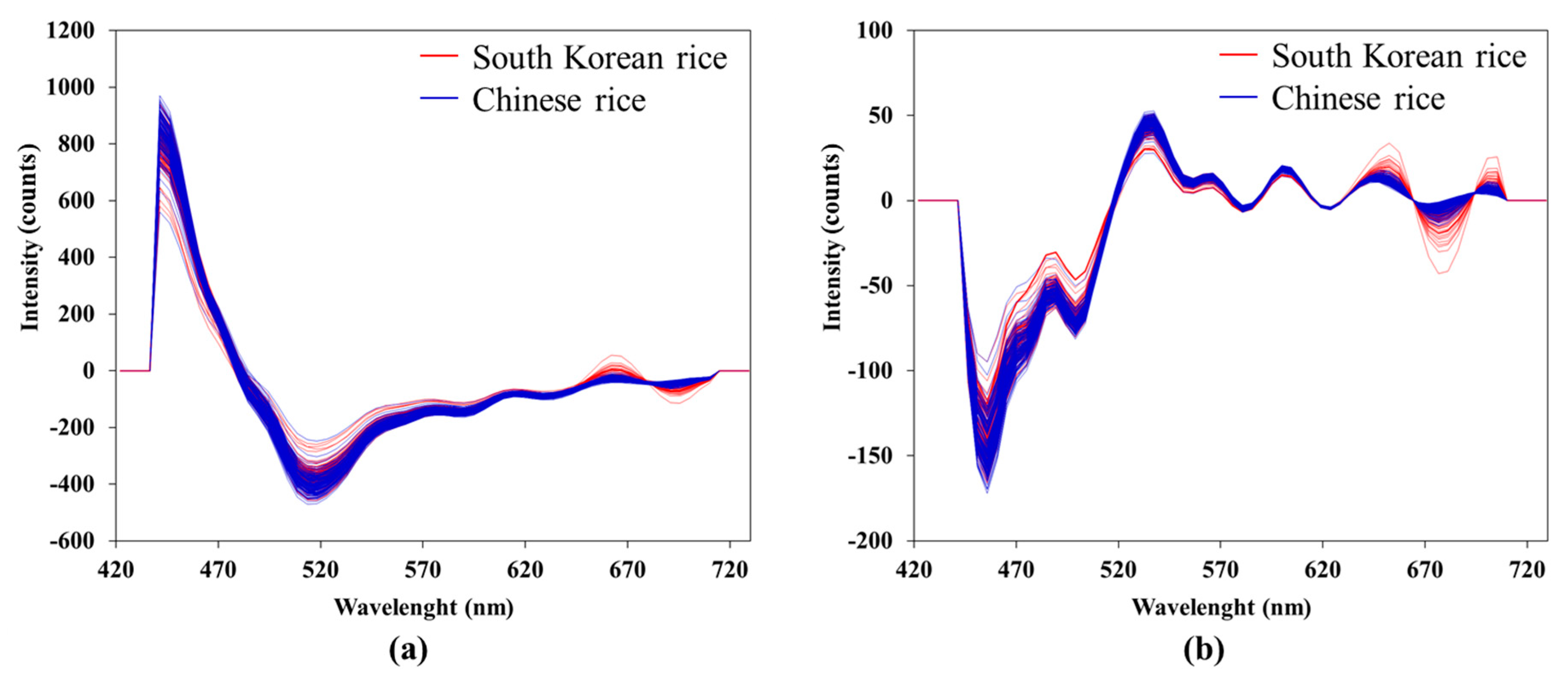
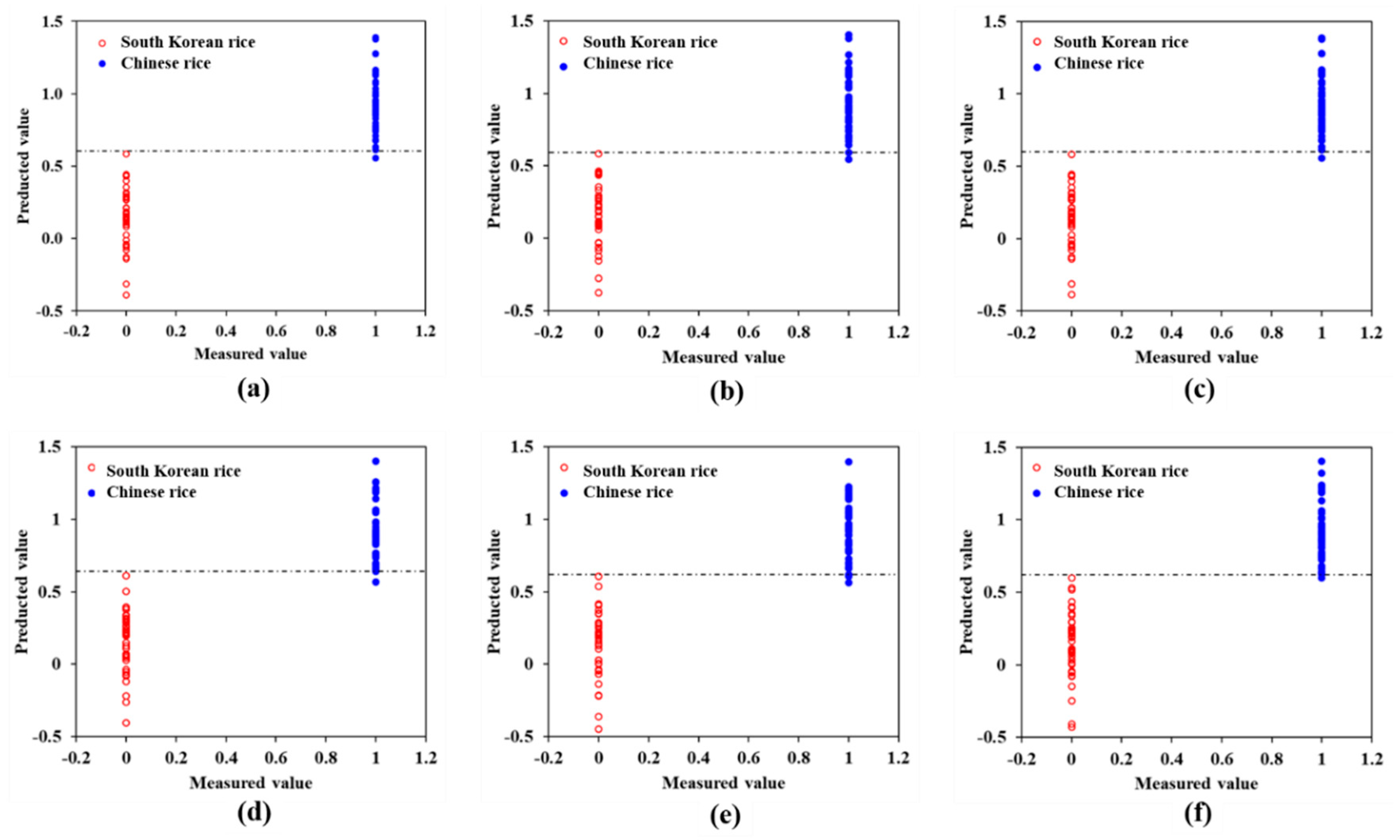

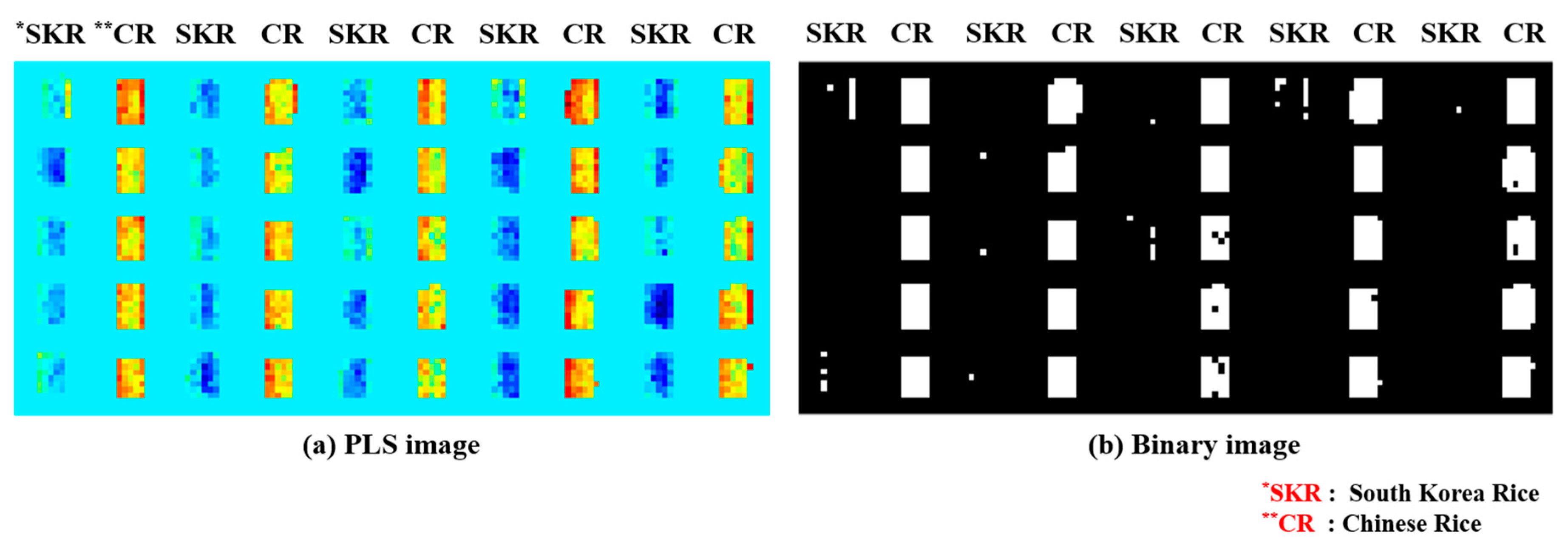
| Nation | Region | 2014 | 2015 | 2016 | ||||||
|---|---|---|---|---|---|---|---|---|---|---|
| Number of Samples | Number of Samples | Number of Samples | ||||||||
| Short-Medium Grain | Long Grain | Total | Short-Medium Grain | Long Grain | Total | Short-Medium Grain | Long Grain | Total | ||
| South Korea | Gyonggi-do | 12 | 0 | 12 | 17 | 0 | 17 | 13 | 0 | 13 |
| Gangwon-do | 7 | 0 | 7 | 8 | 0 | 8 | 6 | 0 | 6 | |
| Chungcheongbuk-do | 3 | 0 | 3 | 4 | 0 | 4 | 1 | 0 | 1 | |
| Chungcheongnam-do | 4 | 0 | 4 | 4 | 0 | 4 | 5 | 0 | 5 | |
| Jeollabuk-do | 6 | 0 | 6 | 5 | 0 | 5 | 12 | 0 | 12 | |
| Jeiollanam-do | 11 | 0 | 11 | 6 | 0 | 6 | 14 | 0 | 14 | |
| Gyeongsangbuk-do | 6 | 0 | 6 | 1 | 0 | 1 | 8 | 0 | 8 | |
| Gyeongsangnam-do | 1 | 0 | 1 | 2 | 0 | 2 | 0 | 0 | 0 | |
| Etc. | - | 0 | - | 1 | 0 | 1 | 0 | 0 | 0 | |
| China | Heilongjiang | 9 | 23 | 32 | 14 | 17 | 31 | 15 | 4 | 19 |
| Jilin | 4 | 4 | 8 | 7 | 3 | 10 | 13 | 8 | 21 | |
| Liaoning | 6 | 0 | 6 | 26 | 0 | 26 | 21 | 0 | 21 | |
| Jiangsu | 2 | 2 | 4 | 1 | 1 | 2 | 2 | 0 | 0 | |
| Pixel Dimension (mm) | |||||||
|---|---|---|---|---|---|---|---|
| 2 × 2 | 3 × 3 | 4 × 4 | 5 × 5 | 6 × 6 | 7 × 7 | 30 × 30 | |
| Training data set | 61,460 | 28,428 | 14,366 | 11,904 | 7170 | 4664 | 294 |
| Predicted data set | 30,730 | 14,214 | 7183 | 5952 | 3585 | 2332 | 83 |
| Pixel Dimension (mm) | |||||||
|---|---|---|---|---|---|---|---|
| 2 × 2 | 3 × 3 | 4 × 4 | 5 × 5 | 6 × 6 | 7 × 7 | 30 × 30 | |
| Rc2 | 0.5763 | 0.6485 | 0.6977 | 0.6925 | 0.7166 | 0.7192 | 0.8023 |
| RMSEC | 0.3244 | 0.2955 | 0.2740 | 0.2766 | 0.2657 | 0.2642 | 0.2218 |
| RV2 | 0.5757 | 0.6475 | 0.6954 | 0.6911 | 0.7148 | 0.7168 | 0.7601 |
| RMSEV | 0.3247 | 0.2960 | 0.2751 | 0.2772 | 0.2662 | 0.2654 | 0.2456 |
| F | 10 | 11 | 10 | 10 | 10 | 9 | 9 |
| Pixel Dimensions (mm) | |||||||
|---|---|---|---|---|---|---|---|
| 2 × 2 | 3 × 3 | 4 × 4 | 5 × 5 | 6 × 6 | 7 × 7 | 30 × 30 | |
| CV a) | 0.545 | 0.555 | 0.55 | 0.56 | 0.53 | 0.51 | 0.60 |
| South Korean rice | 89.83 | 90.47 | 95.13 | 94.83 | 94.17 | 94.52 | >99.99 |
| Chinese rice | 87.42 | 91.34 | 93.70 | 92.47 | 95.77 | 95.86 | 97.78 |
| Total accuracy | 88.63 | 90.90 | 94.42 | 93.65 | 94.97 | 95.19 | 98.89 |
| Pre-Treatment | None | SNV | Baseline | MSC | Normalization | Smoothing | 1D a) | 2D b) | ||
|---|---|---|---|---|---|---|---|---|---|---|
| Mean | Max | Range | ||||||||
| No. of samples | 259 | 259 | 259 | 259 | 259 | 259 | 259 | 259 | 259 | 259 |
| Rc2 | 0.8023 | 0.8160 | 0.8027 | 0.8313 | 0.8126 | 0.8188 | 0.8187 | 0.8014 | 0.7972 | 0.7918 |
| RMSEC | 0.2218 | 0.2140 | 0.2216 | 0.2049 | 0.2159 | 0.2124 | 0.2124 | 0.2223 | 0.2246 | 0.2276 |
| RV2 | 0.7601 | 0.7313 | 0.7586 | 0.7484 | 0.7609 | 0.7463 | 0.7501 | 0.7600 | 0.7684 | 0.7621 |
| RMSEV | 0.2456 | 0.2583 | 0.2458 | 0.2498 | 0.2441 | 0.2518 | 0.2499 | 0.2453 | 0.2416 | 0.2435 |
| F | 9 | 12 | 9 | 13 | 9 | 12 | 12 | 10 | 9 | 8 |
| Pretreatment | None | SNV | Baseline | MSC | Normalization | Smoothing | 1D a) | 2D b) | ||
|---|---|---|---|---|---|---|---|---|---|---|
| Mean | Max | Range | ||||||||
| No. of samples | 83 | 83 | 83 | 83 | 83 | 83 | 83 | 83 | 83 | 83 |
| CV c) | 0.60 | 0.55 | 0.59 | 0.68 | 0.64 | 0.60 | 0.60 | 0.63 | 0.61 | 0.61 |
| South Korea rice | >99.99 | 94.74 | >99.99 | >99.99 | >99.99 | >99.99 | 97.37 | >99.99 | >99.99 | >99.99 |
| Chinese Rice | 97.78 | >99.99 | 97.78 | 95.56 | 95.56 | 97.78 | >99.99 | 97.78 | 97.78 | 97.78 |
| Total Accuracy | 98.89 | 97.37 | 98.89 | 97.78 | 97.78 | 98.89 | 98.68 | 98.89 | 98.89 | 98.89 |
© 2020 by the authors. Licensee MDPI, Basel, Switzerland. This article is an open access article distributed under the terms and conditions of the Creative Commons Attribution (CC BY) license (http://creativecommons.org/licenses/by/4.0/).
Share and Cite
Kim, M.-J.; Lim, J.; Kwon, S.W.; Kim, G.; Kim, M.S.; Cho, B.-K.; Baek, I.; Lee, S.H.; Seo, Y.; Mo, C. Geographical Origin Discrimination of White Rice Based on Image Pixel Size Using Hyperspectral Fluorescence Imaging Analysis. Appl. Sci. 2020, 10, 5794. https://doi.org/10.3390/app10175794
Kim M-J, Lim J, Kwon SW, Kim G, Kim MS, Cho B-K, Baek I, Lee SH, Seo Y, Mo C. Geographical Origin Discrimination of White Rice Based on Image Pixel Size Using Hyperspectral Fluorescence Imaging Analysis. Applied Sciences. 2020; 10(17):5794. https://doi.org/10.3390/app10175794
Chicago/Turabian StyleKim, Min-Jee, Jongguk Lim, Sung Won Kwon, Giyoung Kim, Moon S. Kim, Byoung-Kwan Cho, Insuck Baek, Seung Hyun Lee, Youngwook Seo, and Changyeun Mo. 2020. "Geographical Origin Discrimination of White Rice Based on Image Pixel Size Using Hyperspectral Fluorescence Imaging Analysis" Applied Sciences 10, no. 17: 5794. https://doi.org/10.3390/app10175794
APA StyleKim, M.-J., Lim, J., Kwon, S. W., Kim, G., Kim, M. S., Cho, B.-K., Baek, I., Lee, S. H., Seo, Y., & Mo, C. (2020). Geographical Origin Discrimination of White Rice Based on Image Pixel Size Using Hyperspectral Fluorescence Imaging Analysis. Applied Sciences, 10(17), 5794. https://doi.org/10.3390/app10175794







